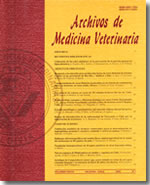Cardiorespiratory evaluation of rabbits (Oryctolagus cuniculus) anesthetized with a combination of tramadol, acepromazine, xylazine and ketamine
Main Article Content
Abstract
Rabbits are considered as difficult animals in relation to anaesthesia due to their anatomical and physiological peculiarities. A mortality rate higher that 5% occurs during general anesthesia; furthermore, anaesthetic combinations that are rarely used include trans-surgical analgesia. Twenty-five clinically healthy New Zealand rabbits (Oryctolagus cuniculus) were anaesthetised with a combination of ketamine (50 mg/kg), xilazine (5 mg/kg) and acepromazine (0.5 mg/kg) intramuscularly; 10 minutes later tramadol (5mg/kg) was applied intravenously. Cardiac and respiratory rates and pulse-oximetry were recorded before the administering anaesthesia at minute "0" and later every 10 minutes until minute 60. The average cardiac rate was 154 ± 28 beats per minute and the average respiratory frequency was 63 ± 33 per minute during the procedure. Average pulse-oximetry was of 88 ± 8 % (P < 0.05). Anaesthetic protocol with tramadol, acepromazine, xylazine and ketamine is safe during surgery training at the used doses, where FC, FR and Ox seem to be stable, however, oxygen supplementation is recommended during anaesthesia.

